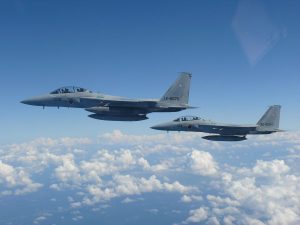A Japan Air Self-Defense Force (JASDF) Mitsubishi-Boeing F-15DJ Eagle fighter aircraft crashed into the Sea of Japan on January 31, resulting in the loss of two pilots.
The twin-seat conversion trainer aircraft, tail number 32-8083, disappeared from radars about 5 kilometers west-northwest of Komatsu Air Base in Ishikawa Prefecture, soon after taking off at around 5:30 p.m. on Monday. The fighter was on its way to a routine training mission.
While the cause of the crash is still being investigated, the incident calls into question the safety of the JASDF’s aging aircraft as well as the pace of its upgrade program.
The crashed F-15DJ had been in operation since 1993, with its total flight time reaching 5,960 hours, according to the JASDF.
In July 2011, an F-15J with the Naha Air Base in Okinawa Prefecture also crashed during a training flight above the East China Sea, killing the pilot. In September 2008, an F-15J with the Tsuiki Air Base in Fukuoka Prefecture plunged into the Sea of Japan off neighboring Yamaguchi Prefecture, but no one was injured.
The service’s F-15J/DJs have been the nation’s mainstay frontline fighter since early 1980s, regularly scrambling to respond to Chinese and Russian military aircraft approaching the country’s airspace.
Mitsubishi Heavy Industries (MHI) under the license of McDonnell Douglas (now part of Boeing) built 163 single-seat F-15Js and 36 twin-seat F-15DJs, plus the first 12 F-15DJ and two F-15J aircraft that were manufactured by McDonnell Douglas.
As of March 31, 2021, Japan had 201 F-15J/DJs, five F-4EJs, 91 F-2A/Bs, and 21 F-35A Joint Strike Fighter aircraft, according to the 2021 Defense of Japan White Paper. That means nearly two-thirds of the nation’s fighter jets are F-15J/DJs.
To respond to the aging aircraft problem and extend their operating life, the Japanese Ministry of Defense (MoD) has put 94 F-15J/DJs through the Multistage Improvement Program (MSIP), which improved an uprated central computer and armament control set and added the J/APQ-1 countermeasures set, among other modifications. The MSIP was for aircraft delivered to the JASDF from 1988 until 1999.
However, the remaining 99 F-15J/DJs – what is called “pre-MSIP” aircraft that were delivered from 1981 to 1984 – are set to be replaced by 105 F-35As and 42 F-35Bs in the coming decade.
Japan is now aiming to improve 98 F-15Js through the proposed F-15 Japan Super Interceptor (JSI) upgrade program. The aircraft will be retrofitted with a series of mission and flight system enhancements that feature in Boeing’s latest F-15EX Advanced Eagle configuration. The F-15Js pegged for the JSI program are mostly ones that already have been through the MSIP.
The JASDF’s F-15DJ aircraft and pre-MSIP F-15Js are not included in the JSI program because they have been deemed unsuitable for additional modernization.
To launch the F-15 JSI program, the U.S. Department of Defense on December 30, 2021, announced a Foreign Military Sale (FMS) award to Boeing for the design and development of an integrated suite of aircraft systems to support modification of the JASDF MSIP F-15J aircraft and the development, test, and delivery of four weapon system trainers.
Work will be performed in St. Louis, Missouri, and is expected to be completed by December 31, 2028. This contract ran as high as $471.3 million, and is part of a larger $4.5 billion modernization program announced by the U.S. Defense Security Cooperation Agency (DSCA) in October 2019.
Boeing and MHI signed a Direct Commercial Sale agreement to support upgrades to Japan’s F-15J fleet in July 2020.
However, there are limits to the “rejuvenation” of aging F-15Js. Also, with Japan’s government debt already standing at 266 percent of GDP – the highest in the world and twice that of the U.S. – there also should be a strict limit as to how much Japan can add to its ballooning national deficit in an attempt to accelerate the F-15 upgrade program despite China’s increasing air capabilities.

































